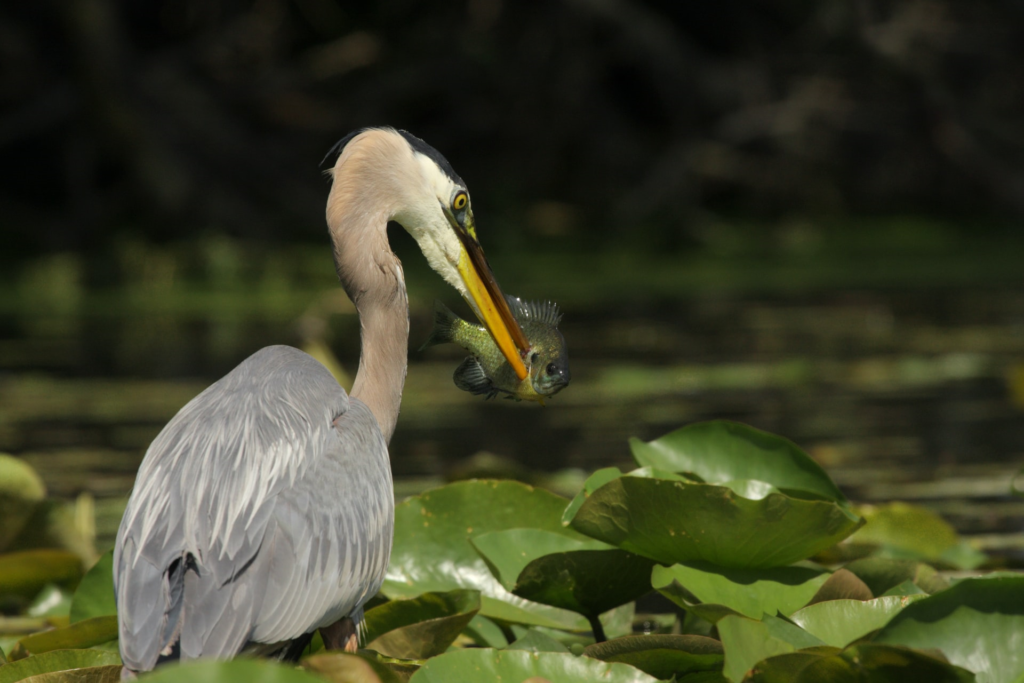http://en.wikipedia.org/wiki/Trophic_level
Trophic levels and Biomass
The trophic level of an organism is the position it occupies on the food chain. The word trophic derives from the Greek τροφή (trophē) referring to food or feeding. A food chain represents a succession of organisms that eat another organism and are, in turn, eaten themselves. The number of steps an organism is from the start of the chain is a measure of its trophic level. Food chains start at trophic level 1 with primary producers, move to herbivores at level 2, predators at level 3 and typically finish with carnivores or apex predators at level 4 or 5. The path along the chain forms a one-way flow along which energy travels in the form of food.
First trophic level
The plants in this image, and the algae and phytoplankton in the lake, are primary producers. They take nutrients from the soil or the water, and manufacture their own food by photosynthesis, using energy from the sun.
The three basic ways organisms get food are as producers, consumers and decomposers.
• Producers (autotrophs) are typically plants or algae. Plants and algae do not usually eat other organisms, but pull nutrients from the soil or the ocean and manufacture their own food using photosynthesis. For this reason, they are called primary producers. In this way, it is energy from the sun that usually powers the base of the food chain. An exception occurs in deep-sea hydrothermal ecosystems, where there is no sunlight. Here primary producers manufacture food through a process called chemosynthesis.
• Consumers (heterotrophs) cannot manufacture their own food, and need to consume other organisms. They are usually animals. Animal that eat primary producers (like plants) are called herbivores. Animals which eat other animals are called carnivores, and animals which eat both plant and other animals are called omnivores.
• Decomposers (detritivores) break down dead plant and animal material and wastes and release it again as energy and nutrients into the ecosystem for recycling. Decomposers, such as bacteria and fungi (mushrooms), feed on waste and dead matter, converting it into inorganic chemicals that can be recycled as mineral nutrients for plants to use again.
Trophic levels can be represented by numbers, starting at level 1 with plants. Further trophic levels are numbered subsequently according to how far the organism is along the food chain.
• Level 1: Plants and algae make their own food and are called primary producers.
• Level 2: Herbivores eat plants and are called primary consumers.
• Level 3: Carnivores which eat herbivores are called secondary consumers.
• Level 4: Carnivores which eat other carnivores are called tertiary consumers.
• Level 5: Apex predators which have no predators are at the top of the food chain.
Second trophic level: Rabbits eat plants at the first tropic level, so they are primary consumers.
Third trophic level: Foxes eat rabbits at the second trophic level, so they are secondary consumers.
Fourth trophic level: Golden eagles eat foxes at the third trophic level, so they are tertiary consumers.
Decomposers: The fungi on this tree feed on dead matter, converting it back to nutrients that primary producers can use.
In real world ecosystems, there is more than one food chain for most organism, since most organisms eat more than one kind of food or are eaten by more than one type of predator. A diagram which sets out the intricate network of intersecting and overlapping food chains for an ecosystem is called its food web.[3] Decomposers are often left off food webs, but if included, they mark the end of a food chain.[3] Thus food chains start with primary producers and end with decay and decomposers. Since decomposers recycle nutrients, leaving them so they can be reused by primary producers, they are sometimes regarded as occupying their own trophic level.
Biomass transfer efficiency
An energy pyramid illustrates how much energy is needed as it flows upwards to support the next trophic level. This diagram is not to scale, because only about 10 % of the energy transferred between each trophic level is converted to biomass.
Generally, each trophic level relates to the one below it by absorbing some of the energy it consumes, and in this way can be regarded as resting on, or supported by the next lower trophic level. Food chains can be diagrammed to illustrate the amount of energy that moves from one feeding level to the next in a food chain. This is called an energy pyramid. The energy transferred between levels can also be thought of as approximating to a transfer in biomass, so energy pyramids can also be viewed as biomass pyramids, picturing the amount of biomass that results at higher levels from biomass consumed at lower levels.
The efficiency with which energy or biomass is transferred from one trophic level to the next is called the ecological efficiency. Consumers at each level convert on average only about 10 percent of the chemical energy in their food to their own organic tissue. For this reason, food chains rarely extend for more than 5 or 6 levels. At the lowest trophic level (the bottom of the food chain), plants convert about one percent of the sunlight they receive into chemical energy. It follows from this that the total energy originally present in the incident sunlight that is finally embodied in a tertiary consumer is about 0.001 %





